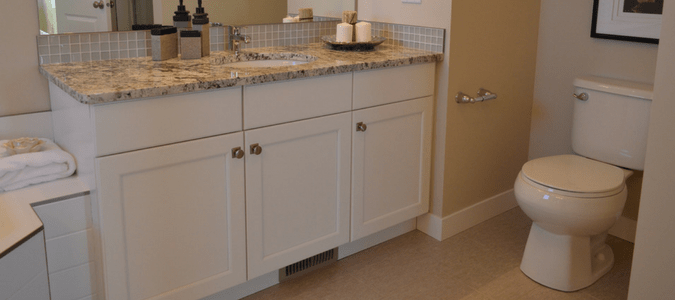
Have you ever walked into your bathroom to find a clogged toilet? If you have, we’re sure you’d prefer not to have to experience that again. If you haven’t, we hate to break it to you, but you probably will at some point. You’ll want to be ready to know what to do when you have to deal with a clogged toilet and which tools are best for the job. Two of the more common tools homeowners use for basic plumbing repairs are toilet augers and snakes.
Toilet Auger vs. Snake
When do you need a toilet auger and in what situations is a snake the right tool for the job? Read on to find out.
The Toilet Auger
One of the most common tools for unclogging a toilet is the toilet auger. Also known as a water closet auger or plumbing snake, this device is designed to move through the drain of the toilet to remove the clog or obstruction that’s causing the stoppage.
Because of its design, it’s able to more effectively remove clogs compared to a regular toilet snake (for more on that, keep reading below). For example, some augers come with a closed coil head, which is used to push through the plug. Others, though, have an open coil head that’s used to hook objects for retrieval. Most designs, though, have a long, flexible shaft that includes an auger bit at one end, a crank handle on the other. Augers are usually made of metal.
The Top Snake
One of the smallest tools used for clogged drains is the top snake. Unlike the auger, though, a snake is mainly used to remove clogs in other appliances, like your tubs, showers, bathroom sinks, washing machines and even your kitchen sink. They vary in size and shape depending on the tasks at hand.
The regular toilet snake, however, is simply a wire coil with a corkscrew-like tip that goes into your pipes to find the clog. Most toilet snakes have a long cable cord and are used if there’s not too much buildup.
The Plunger
We should also mention that before trying a toilet auger or a snake, which you may not own, you’ll probably try a plunger to remove the obstruction. You may not realize that there are actually two types of plungers: cup plungers and flange plungers. The cup plunger is the type you will most easily recognize and can be used in sinks as well as bathtubs and showers. The flange plunger is better for toilets, as its design allows for a tighter seal. To increase your chances of success, make sure your plunger is clean and free of any tears. Avoid using a plunger after you have applied drain cleaners, as you will risk spreading dangerous chemicals onto your skin of clothing. If you have a large amount of water that has collected in your tub, you may consider removing some of it before you use the plunger to reduce the amount of mess you will make. When you are ready, make sure you get a tight seal and then apply up and down pressure at a perpendicular angle to the floor of your tub or sink or your toilet’s base.
How and When to Use Each Tool
Like we mentioned above, you’ll probably want to tackle a minor clog with a plunger first. For more stubborn clog, an auger is your next best bet. To use the auger properly, situate the curved end of the auger handle pipe so that it’s facing the same direction as the drain. Be sure to leave four to six inches of cable between the drain and the end of the handle pipe. Tighten the auger’s screw.
Once you’ve situated the auger correctly, push the cable through the toilet drain and turn it in a clockwise motion. When it can’t turn any more, push the cable forward. You should feel the auger grab something or break up the clog. At that point, turn and pull the cable back out of the drain. After the auger is removed from the toilet drain, use a plunger to break up any final clogs and flush the toilet.
Keep in mind that using force will not help the situation. In fact, it can cause more harm than good, as it can cause the porcelain in your toilet to crack or chip. It can also cause pipe damage or even full breakage.
When using a snake, however, the key is to slowly feed the wire coil into your toilet’s pipe. Once you feel like you’ve encountered the clog, similar to the auger, begin to twist the coil. Doing so will enable you to hook the clog or cause enough movement to break it up. Keep in mind that you might have to remove the coil, clean, and reinsert it a few times before the clog is fully removed.
Just like the toilet auger, using a snake has potential dangers involved. Due to its coiled design, a basic toilet snake can recoil back on you while in use. And similar to the auger, it can scratch and damage the toilet’s pipes.
Trust ABC To Tackle Your Toilet Troubles
While it’s possible to successfully clear your toilet’s clogged drain yourself, your best bet is to call your local plumbing service company. Our team at ABC Home & Commercial Services is trained and ready to tackle any plumbing problems. With our help, you can rest easy knowing your plumbing problems will soon be a thing of the past. Schedule a service today.
